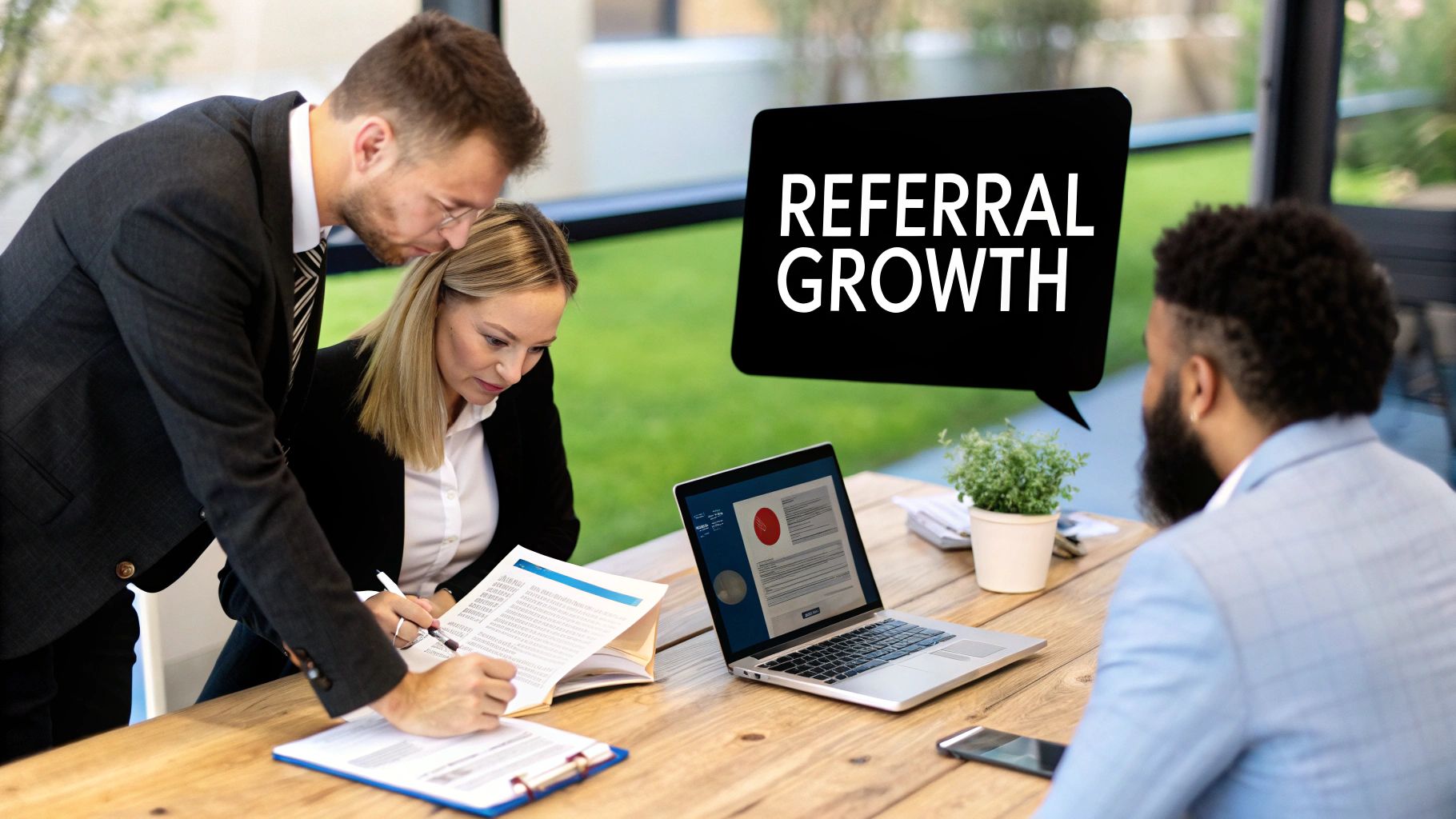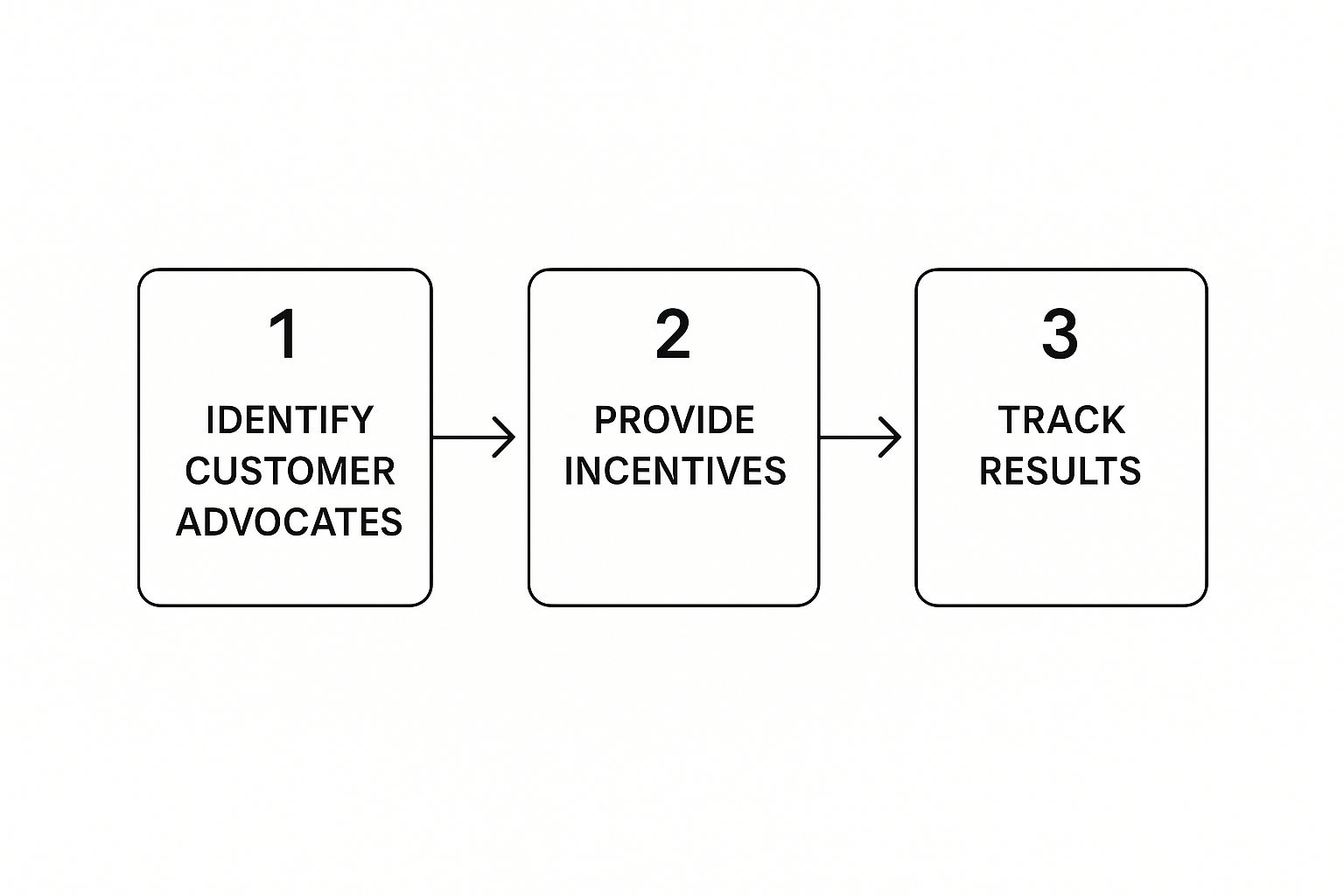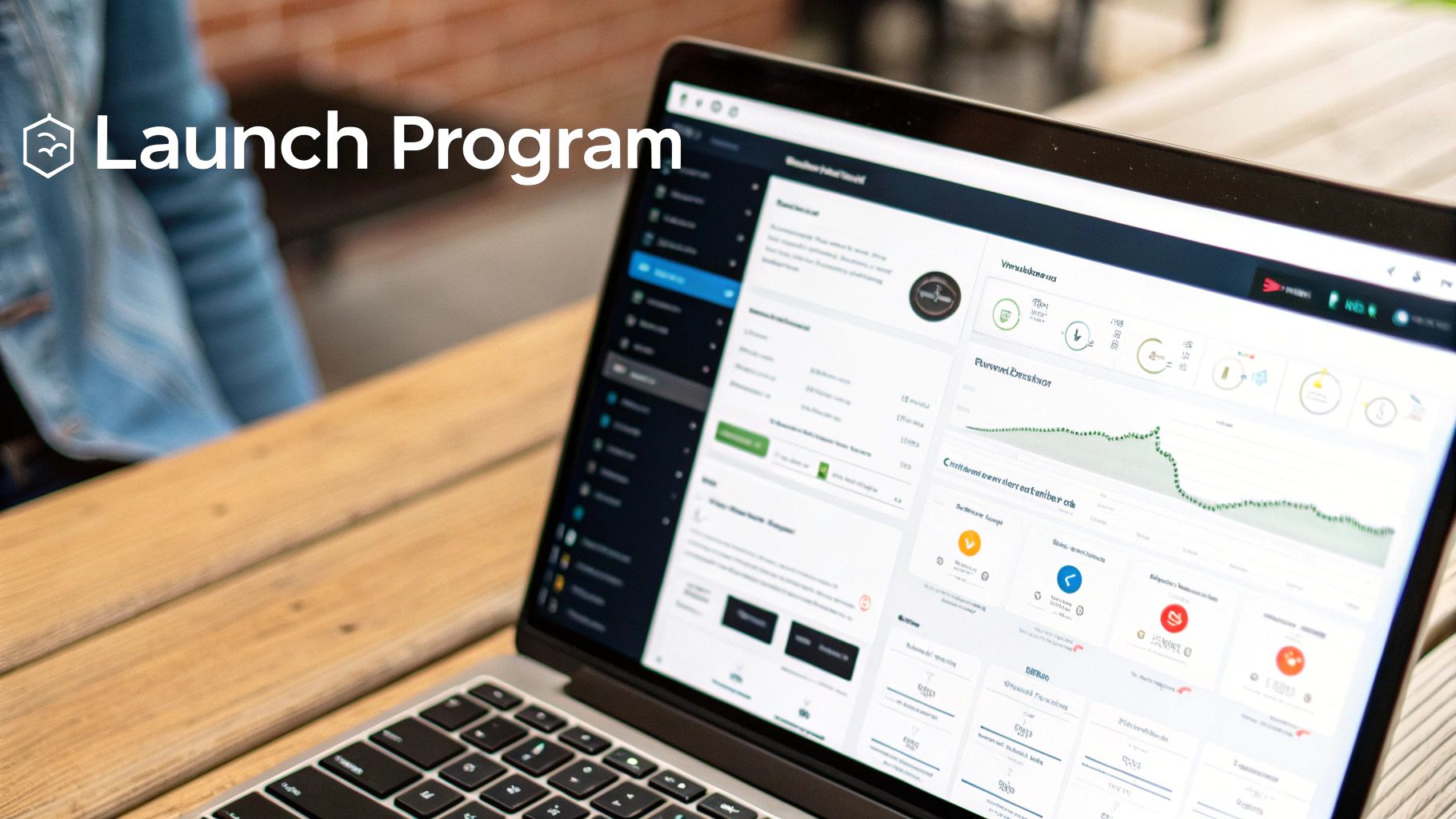Finding and winning over high-value B2B clients is a tough, expensive game. You're often up against long sales cycles and decision-makers who are naturally skeptical. This is where B2B referral marketing comes in. It’s not just about hoping for word-of-mouth; it's a deliberate system that encourages your happiest customers and partners to recommend you, turning their hard-earned credibility into your best source of growth.
Essentially, you're tapping into pre-existing trust to get high-quality leads that close faster and stick around longer.
The Hidden Power of Trust in B2B Marketing

In the B2B world, trust isn't just a bonus—it's the currency of every deal. Think about traditional outbound marketing, like cold calls or mass emails. It’s like showing up to a stranger’s office uninvited. You have to build your credibility from absolute zero, which burns a ton of time and money.
A referral completely flips that script. It’s the equivalent of being personally introduced by a mutual, respected colleague. That initial wall of skepticism just crumbles. When one of your clients tells a peer about your solution, they’re putting their own reputation on the line for you. This "borrowed trust" is the magic that makes B2B referral marketing so incredibly effective.
Why a Recommendation Outperforms Any Ad
A referral isn't just another lead; it's a pre-qualified opportunity. The prospect comes to you with a positive first impression and a real problem to solve, because the person who referred them already knows your business and their challenges. This connection is what dramatically shortens the notoriously long B2B sales cycle.
A referral is more than a warm introduction—it's a validation of your value from a credible source, giving you an immediate competitive advantage before the first sales call even happens.
This strategy effectively turns your satisfied customers into a powerful extension of your marketing department. They become your most genuine and convincing advocates, opening doors you could never get through on your own.
And the numbers back this up. A staggering 84% of B2B sales start with a referral, and 73% of B2B executives prefer to work with sales professionals referred by someone they know. You can dive deeper into these B2B referral statistics from Referral Rock. This data really drives home how much trust shapes high-stakes business decisions.
Comparing Lead Generation Approaches
To truly grasp the power of referrals, it's helpful to see how they stack up against leads from more traditional sources. The difference isn't subtle—it's a night-and-day comparison in terms of quality and efficiency.
The table below breaks down the key distinctions.
Referral Leads vs Traditional Leads at a Glance
| Attribute | B2B Referral Marketing | Traditional Outbound Marketing |
|---|---|---|
| Trust Level | Starts high; trust is "borrowed" from the referrer. | Starts at zero; must be built from scratch. |
| Sales Cycle | Shorter; the lead is pre-educated and pre-vetted. | Longer; requires extensive nurturing and proof. |
| Conversion Rate | Significantly higher due to inherent trust and better fit. | Lower; leads are often unqualified or not ready to buy. |
| Cost of Acquisition | Lower; relies on existing relationships, not ad spend. | Higher; involves costs for ads, sales teams, and tools. |
| Lead Intent | High; the prospect is actively seeking a solution. | Varies widely; often low or purely informational. |
As you can see, leads from cold outreach demand a ton of nurturing just to get them warmed up. On the other hand, referred leads walk in the door with a much higher level of intent and qualification, ready to talk business.
Ultimately, by creating a formal process to encourage and track these introductions, you're not just hoping for referrals—you're building a predictable, high-ROI engine for sustainable growth.
Why Referrals Are a Financial Game-Changer

While trust is the heart of referral marketing b2b, its real strength shows up on your balance sheet. In a world where customer acquisition costs (CAC) just keep climbing, referrals offer a powerful financial relief. They essentially turn your happiest customers into a predictable, incredibly cost-effective growth engine.
This isn't just about soft benefits; we're talking about tangible ROI. A smart referral program directly improves your most critical financial numbers. It shrinks your sales cycles, drives up conversion rates, and boosts the lifetime value (LTV) of your customers—making the business case for investing in a program crystal clear.
Slashing Customer Acquisition Costs
The most immediate financial win you'll see is a huge drop in your CAC. Think about it: traditional marketing means spending a ton on ads, content, and sales outreach just to get the attention of total strangers. Referrals let you sidestep a lot of that expensive, top-of-funnel grind.
Your advocates do the heavy lifting for you, delivering prospects who are already warmed up and genuinely interested. This direct line from a recommendation to a sales conversation is incredibly efficient. Deloitte even found that companies with formal referral programs see a 24% reduction in customer acquisition costs. This is especially critical as other marketing costs continue to soar.
That efficiency means every dollar in your marketing budget works harder. You can then reinvest those savings into your product or customer experience, which—you guessed it—fuels even more referrals. It’s a powerful, self-sustaining loop of growth.
Amplifying Conversion Rates and Sales Velocity
Referred leads don't just cost less; they close at a much higher clip. They walk in the door with a built-in layer of trust, so your sales team can skip the initial "who are you and why should I care?" song and dance. They can get straight to solving the prospect's actual problems.
A referred prospect enters the sales process with high intent and a positive bias. This means less friction, fewer objections, and a much shorter path from lead to closed deal.
This speed has a massive impact on your bottom line. A major financial benefit of B2B referral marketing is its role in boosting your lead to sale conversion rate. When your team closes deals faster, they can manage more opportunities, directly increasing revenue without you needing to hire more salespeople.
Increasing Customer Lifetime Value
The financial perks don't stop once the contract is signed. Customers who come in through a referral are often more loyal and have a much higher lifetime value (LTV) than customers from any other channel.
Why does this happen? A few things are at play:
- Better Fit: The person making the referral knows both your product and the new customer's needs, creating a much stronger match from day one.
- Shared Networks: The new customer is often in the same professional circle as the referrer, which constantly reinforces your product's value.
- Higher Satisfaction: Kicking off the relationship from a place of trust usually leads to smoother onboarding and a better overall experience.
All these factors add up to stickier, more valuable customer relationships. When you run the numbers and compare the LTV of your referred customers to your average, the positive financial impact is impossible to ignore. It proves that a solid referral strategy is a must-have for long-term, profitable growth. To dive deeper into structuring a program, our guide on https://refgrow.com/blog/referral-marketing-strategies is a great next step.
How to Build Your B2B Referral Program
It's one thing to understand the financial upside of B2B referral marketing, but it’s a whole different ball game to actually build a program that delivers those results. A top-tier system isn’t about just casually asking for introductions. It’s about creating a thoughtful, structured approach that turns your happiest customers into a genuine growth engine for your company.
A successful program really boils down to three core pillars: figuring out who your most enthusiastic fans are, offering them incentives that actually motivate a professional audience, and making the entire referral process dead simple. Nail these three, and you'll turn passive customer satisfaction into active, measurable promotion.
Pinpoint Your Most Passionate Advocates
First things first: you need to identify who to ask. Your best advocates aren't just any customers; they're the ones who have seen real success with your product and are genuinely thrilled with the results. These are your most credible and convincing champions.
To find them, you have to look for clear signals of satisfaction and loyalty. These are the clients who have already shown they feel positively about your business, making them perfect candidates for your referral program.
- Dig into Customer Data: Look for your long-term users, customers with sky-high product engagement, or those who recently upgraded their plans. These actions all scream, "We see real value here!"
- Monitor Feedback Channels: Keep a close eye on positive online reviews and social media shout-outs. A client who takes the time to praise you publicly is often more than willing to do the same for their private network.
- Leverage Your Net Promoter Score (NPS): Your "Promoters"—the folks who score you a 9 or 10—are literally telling you they are ready to recommend you. This is the lowest-hanging fruit you'll find for your referral outreach.
Once you’ve got this list, you're ready to start putting the pieces together. For a more detailed guide, check out our in-depth article on building a referral program from the ground up.
Create Incentives That Motivate Action
With your advocates identified, the next step is giving them a compelling reason to actually participate. B2B incentives are a different beast than their B2C cousins. A small discount might work for a consumer product, but B2B referrals are a reflection of professional reputations. The rewards need to feel appropriate and valuable within a business context.
Think beyond just cash. While money is often effective, it’s not your only play. The best rewards are the ones that align with your customers' professional goals and your existing business relationship. You might also consider a double-sided incentive, where both the person referring and the new customer get a benefit. This helps the referrer feel like they're giving a gift, not just trying to cash in.
Don’t assume cash is the only motivator. In B2B, rewards like service credits, access to premium features, or exclusive content can be far more valuable and professionally appropriate than a simple gift card.
As you build out your program, it's worth exploring different models. A dedicated affiliate program, for example, can provide more structured incentives and tracking. You can see a great example of this in action with Spur's Affiliate Program.
This infographic shows the fundamental flow of a successful program, from identifying your best advocates to rewarding them for the results they bring in.

This simple process makes it clear: a great program moves in a logical sequence, creating a repeatable loop for generating high-quality leads.
Make the Referral Process Effortless
The final—and arguably most crucial—pillar is simplicity. If your referral process is clunky, confusing, or takes too much time, even your biggest fans won't bother. The goal is to make sharing your business take as few clicks as humanly possible.
You have to remove every ounce of friction. Your customers are busy professionals, and their time is gold. A clunky submission form or an unclear process will kill participation before it ever gets off the ground.
- Provide Unique Referral Links: Give every advocate their own unique, easy-to-copy referral link. This makes sharing a breeze and ensures you can accurately track every single lead that comes in.
- Offer Pre-Written Templates: Create pre-drafted email and social media messages that advocates can use. Just make sure they can easily personalize them to add their own authentic voice.
- Ensure Clear Instructions: Explain how the program works in 3-4 simple steps. Be crystal clear about what the advocate needs to do, what the reward is, and when they can expect to get it.
By making the process frictionless, you're showing respect for your customers' time. In return, you’ll dramatically increase the odds that they take action, turning their goodwill into tangible, high-value leads for your business.
Choosing Incentives That Actually Work in B2B

The engine that drives any successful referral marketing b2b program is its incentive structure. But here’s the thing: what motivates a B2B professional is worlds apart from what works for a typical consumer. A simple cash reward or a discount might not just fall flat—it could come across as inappropriate or even violate the referrer's corporate gift policy.
In the B2B world, a referral isn't just a friendly tip; it's a professional endorsement. The person referring your SaaS is putting their reputation on the line, vouching for your ability to deliver. Because of this, the rewards need to respect that professional context. They must offer genuine value that aligns with business goals, not just personal gain.
Monetary vs. Non-Monetary Rewards
One of the first decisions you'll make is whether to offer cash or non-cash incentives. It's a critical choice. Monetary rewards, like gift cards or direct payments, are easy to understand and universally accepted. But they're not always the best fit for B2B. Often, the person making the referral isn't the one who pays the invoices, which can make a subscription credit feel a little hollow.
On the other hand, non-monetary rewards can feel much more valuable and professionally integrated. These rewards often provide a direct benefit to the referrer’s business or career, strengthening their relationship with your brand in a far more meaningful way.
Here’s a quick breakdown of the two approaches:
| Reward Type | Pros | Cons |
|---|---|---|
| Monetary Rewards | Universally appealing, easy to understand, and very flexible for the recipient. | Can feel purely transactional, might violate company policies, may not motivate all stakeholders equally. |
| Non-Monetary Rewards | Professionally appropriate, reinforces your product's value, and helps build lasting brand loyalty. | Might be less motivating if the reward isn't desired, can have a lower perceived value than straight cash. |
Ultimately, the right choice comes down to knowing your advocates. What do they really value?
Powerful B2B Incentive Structures
It's not just about what you give; it's also about how and when you give it. The structure of your incentive program can make a massive difference in participation and the quality of leads you get.
Here are a few powerful models to consider for your referral marketing b2b strategy:
- Double-Sided Rewards: This is the classic win-win. The referrer gets a reward, but so does the new customer they bring in (think an initial discount or a bonus feature). This simple shift turns the referral from a self-serving act into a generous gift, making your advocates feel much more comfortable sharing.
- Tiered Incentives: Why should every referral be treated the same? With a tiered system, you offer increasingly valuable rewards as an advocate brings in more successful referrals. For example, their first referral might earn a $100 gift card, their third earns $250, and their fifth unlocks premium support access for a year.
- Multi-Step Rewards: We all know B2B sales cycles can be long. Keep your advocates engaged throughout the journey by rewarding them for hitting key milestones, not just for the final sale. You could offer a smaller reward when their referral books a qualified demo and a much larger one when they officially sign on as a customer.
In B2B, the best incentives are often those that provide professional value. Think less about gift cards and more about offering access to premium support, exclusive industry reports, or free passes to a webinar that can help your advocate in their own career.
This approach honors the professional relationship at the heart of the referral. By aligning your rewards with the business context, you create a system that your advocates are actually proud to participate in, turning them into a reliable engine for high-value growth.
Measuring the Success of Your B2B Referral Program
Launching a B2B referral marketing program without a way to measure it is like flying blind. Sure, you're moving, but are you getting any closer to your destination? To get the most out of your efforts and actually prove the program’s value, you have to track the right key performance indicators (KPIs).
You simply can't improve what you don't measure. Focusing on the right metrics takes you beyond vanity numbers, like total shares, and drills down into the data that signals real business growth. It's all about building a clear dashboard to see what's working and using those insights to fine-tune your approach for the best possible return.
Core Metrics for Your B2B Referral Dashboard
To get a true feel for your program's health, you need to look at more than just one number. A great program is a balancing act between encouraging participation and delivering real business results. The best way to see the full picture is by tracking a few core metrics that, when viewed together, tell the complete story from referral to revenue.
Here are the essential KPIs you should have on your dashboard:
- Referral Rate (or Participation Rate): This is your starting point. It tells you what percentage of your customers are actually making referrals. If this number is low, it could mean you need to work on promoting the program, the incentives aren't quite right, or it’s just too complicated for people to use.
- Lead Conversion Rate: This is the ultimate test of lead quality. What percentage of the friends and colleagues your customers refer actually become paying customers? A high conversion rate is a fantastic sign that your advocates are sending highly qualified prospects your way.
- Cost Per Acquisition (CPA): How much are you spending to get a new customer through referrals? You can figure this out by dividing your total program costs (rewards, platform fees, etc.) by the number of new customers you've landed. This number is gold when you compare the efficiency of your B2B referral marketing against other channels like paid search or content.
Tracking these three metrics gives you a rock-solid foundation. You’ll understand how engaged your advocates are and how financially efficient the program is.
The Most Important Metric of All
While those KPIs are critical for the day-to-day health of your program, one metric truly proves the long-term financial power of your referral strategy: Customer Lifetime Value (LTV). Time and time again, we see that customers who come in through a referral have a higher LTV than customers from any other channel.
Why does this happen? It’s pretty simple, really. Referred customers tend to be a better fit from day one, which leads to higher satisfaction and better retention. They arrive with a built-in layer of trust—they believe the judgment of the person who referred them—so they start the relationship on a positive note and are more likely to stick around.
When you compare the LTV of referred customers to the LTV of customers from other marketing channels, the true financial story of your program comes into focus. A higher LTV for referred customers is the ultimate proof that your program isn't just bringing in leads, but attracting your most valuable and loyal clients.
This single comparison allows you to build an undeniable business case for investing more in your referral initiatives. It shifts the entire conversation from short-term wins to long-term, sustainable growth powered by your biggest fans. By focusing on these specific measurements, you can turn your referral program from a hopeful experiment into a predictable, powerful engine for scaling your business.
Giving Your Referral Program the Right Tools to Succeed
Trying to run a B2B referral marketing program by hand, juggling spreadsheets and email reminders, is a fast track to headaches and missed opportunities. As you grow, that manual approach just doesn't work. It’s a clumsy experience for your customers, a massive time-drain for your team, and a nightmare to track with any real accuracy.
To get the most out of your referrals, you have to bring in automation. This is exactly what modern, dedicated referral platforms are built for. These tools take care of the entire process—from creating unique sharing links to tracking new customers and sending out rewards. This frees up your team to focus on what matters: building relationships, not wrestling with data entry.
The real goal here is to make your referral program feel like a natural part of your product—not some clunky, bolted-on system that just confuses people.
Why an Embedded Platform Is a Game-Changer
The most effective referral tools are the ones you can embed directly into your own app or customer portal. It just makes sense. Asking a happy customer to leave your platform and log into a separate, strange-looking website just to refer someone? That’s adding a massive amount of friction. It's like telling them to walk down the street to a different office just to drop off a recommendation.
An embedded platform gets rid of that barrier completely. It puts the referral program right where your customers already are, making it incredibly easy for them to participate.
When you embed a referral program directly into your SaaS app, it stops feeling like a marketing campaign and starts feeling like an organic, valuable feature of your product. This native experience builds trust and sends participation rates through the roof.
With this setup, your advocates can grab their unique referral link, check on the status of their referrals, and see their rewards—all without ever leaving your product’s environment. It creates a smooth, professional experience that keeps everything on-brand.
What Does Setup Actually Look Like?
Getting a modern referral program up and running is more straightforward than you might think. While every platform has its own quirks, the core steps are designed to be quick and efficient. The idea is to take you from a concept to a fully automated program without a ton of technical work.
Here's a typical look at the implementation process:
- Connecting Your Systems: First things first, you’ll connect the referral platform to your key business tools. This usually means integrating with your CRM (like HubSpot or Salesforce) to keep track of new leads and your payment processor (like Stripe) to automate reward payouts. This makes sure all your data talks to each other seamlessly.
- Making It Your Own: Next, you'll customize the referral dashboard so it matches your company's branding perfectly. This is also where you'll define your reward structure—maybe it's a $100 gift card for a signed contract, or perhaps you'll offer service credits as a non-cash incentive.
- Unique Tracking Links: Once everything is configured, the platform automatically creates a unique referral link for every single advocate. This is the magic ingredient for accurate tracking, ensuring every new customer is credited to the right person, every time.
- Automated Updates: Finally, you'll set up automated emails to keep everyone in the loop. These messages can notify referrers when their friend becomes a lead, update them when a deal closes, and confirm when their reward has been sent.
If you want to make sure your program is set up for success from day one, it’s worth looking into proven strategies. You can dive deeper by reading our complete guide on referral program best practices.
By automating these critical (but tedious) tasks, you build a system that practically runs itself. This allows your B2B referral marketing strategy to scale right alongside your business, making sure you never lose a lead or forget to reward a loyal advocate. It's how you build a predictable and powerful engine for growth.
Got Questions About B2B Referrals? We’ve Got Answers.
Jumping into referral marketing b2b can feel like you're navigating a new landscape. It's totally normal to have questions. This section is designed to give you straightforward answers to the things people ask us most, cutting through the jargon to give you practical advice you can use right away.
When Is the Best Time to Ask a B2B Customer for a Referral?
Timing is everything. You can't just ask out of the blue. The sweet spot is right after you've delivered a big win for your client and they're feeling great about your partnership. When their satisfaction is at its peak, asking for a referral feels less like a request and more like a natural next step.
Keep an eye out for these golden opportunities:
- Right after they've had a super smooth onboarding experience.
- Following a glowing quarterly business review (QBR) where you've demonstrated clear ROI.
- The moment a customer gives you a 9 or 10 on a Net Promoter Score (NPS) survey.
- When a client sends you a "you guys are awesome" email completely unprompted.
When you ask at these moments, you're not just asking for a name; you're giving them a chance to share a success story they're genuinely proud of.
How Are B2B and B2C Referral Programs Different?
The biggest difference comes down to what’s at stake. B2B programs are a whole different ballgame. We’re talking about much longer sales cycles, way bigger deal values, and decisions made by a committee, not just one person. A B2B referral isn't a casual shout-out—it’s a serious professional endorsement that puts someone's reputation on the line.
In the B2B world, trust is everything. That’s why incentives need to be professional and add real value. Think service credits, an upgrade to premium support, or exclusive co-marketing opportunities—not the small cash bonuses or gift cards that work so well in B2C.
How Do I Get the Word Out About My B2B Referral Program?
You have to be smart about promoting your program. If you build it, they won't just come; you have to actively and consistently let your best customers know it exists without being pushy.
A great starting point is a targeted email campaign to your happiest, most engaged clients. Next, empower your customer success team to bring it up naturally in conversations where it makes sense. Most importantly, make it dead simple to join by embedding a clear, easy-to-find link to the program right inside your app or customer portal. This makes participation a no-brainer.
Ready to turn your happiest customers into your most effective sales channel? With Refgrow, you can launch a fully native, automated referral program right inside your SaaS platform in minutes. It's time to ditch the messy spreadsheets and start building a reliable growth engine. Explore Refgrow today and see just how easy it is to get started.

